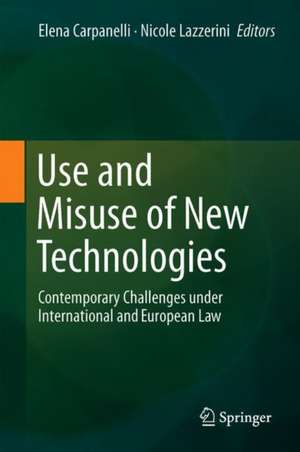Use and Misuse of New Technologies: Contemporary Challenges in International and European Law
Editat de Elena Carpanelli, Nicole Lazzerinien Limba Engleză Hardback – 24 mai 2019
The ever-increasing use of technology is challenging the current status of the law, bringing about new problems and questions. The book addresses this trend from the perspective of International law and European Union law and is divided into three main thematic sections. The first section focuses on the legal implications of the use of technology either for law enforcement purposes or in the context of military activities, and examines how this use adds a new dimension to perennial issues, such as the uneasy balance between security concerns and the protection of individual rights, and defining the exact scope of certain State obligations. In so doing, it takes into account a range of current and potential scenarios at the international, regional and domestic level, including the use of killer robots, databases, drones and technology in general to patrol borders, exchange information on criminal suspects, maintain public order, target suspected terrorists and conduct military activities.
In turn, the second section examines the role of institutional and non-institutional actors in establishing substantive normative standards for the use of high-tech applications. In this respect, it focuses both on the role that European courts have played so far, and on how other actors’ initiatives can contribute to the construction of a new legal framework for technology-related activities. Lastly, the third section has a two-fold focus: the first part investigates how the increasing reliance on technology is affecting traditional rules on international responsibility, and is challenging, in particular, the attribution of wrongful conduct to States and international organizations. The second part addresses issues of jurisdiction and justiciability.
Given the scope of its coverage, this timely book addresses an important lacuna in the current legal scholarship, exploring some of the most recent applications of technology and the legal issues arising as a result. Readers will gain novel insights into the challenges posed to International law and European law by the growing reliance on technology, taking into account both its uses and misuses.
Preț: 1118.13 lei
Preț vechi: 1363.58 lei
-18% Nou
Puncte Express: 1677
Preț estimativ în valută:
213.98€ • 222.57$ • 176.65£
213.98€ • 222.57$ • 176.65£
Carte tipărită la comandă
Livrare economică 14-28 aprilie
Preluare comenzi: 021 569.72.76
Specificații
ISBN-13: 9783030056476
ISBN-10: 3030056473
Pagini: 540
Ilustrații: XVIII, 363 p.
Dimensiuni: 155 x 235 mm
Greutate: 0.71 kg
Ediția:1st ed. 2019
Editura: Springer International Publishing
Colecția Springer
Locul publicării:Cham, Switzerland
ISBN-10: 3030056473
Pagini: 540
Ilustrații: XVIII, 363 p.
Dimensiuni: 155 x 235 mm
Greutate: 0.71 kg
Ediția:1st ed. 2019
Editura: Springer International Publishing
Colecția Springer
Locul publicării:Cham, Switzerland
Cuprins
Part I Legal implications of the use of new technologies in law enforcement activities and beyond.- Part II The role of courts and other actors in defining normative standards for technology-related challenges.- Part III Addressing violations deriving from the use of new technologies: Issues of responsibility and judicial protection.
Recenzii
“The book presented here would be an essential starting point. ... Most importantly, it brings together a comprehensive collection of work on the current state and the future challenges of the relationship between international law (IL) and technology, equally interesting for scholars, practitioners and lawmakers. ... the volume, which makes it an even more useful instrument for public law scholars who want to engage with such topics.” (Rachel F. Behring and Angelo Golia, ZaöRV - Zeitschrift für ausländisches öffentliches Recht und Völkerrecht, Vol. 80 (3), 2020)
Notă biografică
Elena Carpanelli, University of Parma, Italy
Nicole Lazzerini, University of Florence, Italy
Textul de pe ultima copertă
The ever-increasing use of technology is challenging the current status of the law, bringing about new problems and questions. The book addresses this trend from the perspective of International law and European Union law and is divided into three main thematic sections. The first section focuses on the legal implications of the use of technology either for law enforcement purposes or in the context of military activities, and examines how this use adds a new dimension to perennial issues, such as the uneasy balance between security concerns and the protection of individual rights, and defining the exact scope of certain State obligations. In so doing, it takes into account a range of current and potential scenarios at the international, regional and domestic level, including the use of killer robots, databases, drones and technology in general to patrol borders, exchange information on criminal suspects, maintain public order, target suspected terrorists and conduct militaryactivities.
In turn, the second section examines the role of institutional and non-institutional actors in establishing substantive normative standards for the use of high-tech applications. In this respect, it focuses both on the role that European courts have played so far, and on how other actors’ initiatives can contribute to the construction of a new legal framework for technology-related activities. Lastly, the third section has a two-fold focus: the first part investigates how the increasing reliance on technology is affecting traditional rules on international responsibility, and is challenging, in particular, the attribution of wrongful conduct to States and international organizations. The second part addresses issues of jurisdiction and justiciability.
Given the scope of its coverage, this timely book addresses an important lacuna in the current legal scholarship, exploring some of the most recent applications of technology and the legal issues arising as a result. Readers will gain novel insights into the challenges posed to International law and European law by the growing reliance on technology, taking into account both its uses and misuses.
Caracteristici
Deals with complex, cutting-edge issues that, though increasingly relevant on the current legal landscape, have not been thoroughly addressed in academic research Features contributions by young scholars whose core research activities focus on the specific topics they discuss Provides an overview of the most relevant issues in the field, which are approached from a two-fold perspective
